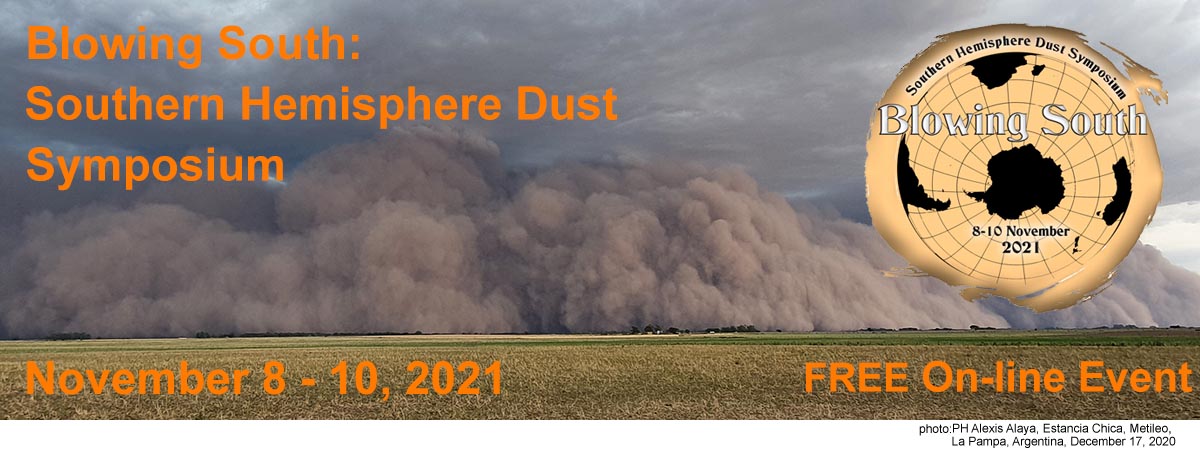
Registration:
Registration is FREE and now open for the eventplease click here
Abstract submission has closed
Decision letters on abstract acceptance and allocation of time slots for talks
will be e-mailed in early October 2021, along with the full event agenda,
which will also be made available on this website.
Blowing South:
Southern Hemisphere Dust Symposium
On-line Event, November 8th, 9th & 10th, 2021
Rationale:
Dust is an essential component of the climate and the Earth system dynamics, participating in feedbacks with the radiative balance, precipitation, atmospheric and ocean biogeochemistry and land use, including impacts on human health. Compared to the Northern Hemisphere, dust in the Southern Hemisphere has traditionally received less attention. However, a growing body of literature stresses the importance of dust in southern latitudes, since southern land masses are the most important sources of dust deposited on the southern oceans, the most extensive of the high-macronutrient, low-chlorophyll water bodies. In southern polar and subpolar regions, the long-range transport of dust potentially affects high-latitude albedo of snow- and ice-covered surfaces.
Symposium Aim:
Participants will discuss the latest advances in their work and share their major scientific questions. This will provide an opportunity to discuss recent and on-going work on these critical issues, and to expand on pre-existing collaborations that in certain areas of research and in certain regions are still quite limited.
Confirmed keynote speakers:
- Diego Gaiero. CICTERRA, CONICET-UNC,
"Contributions to the study of southern hemisphere Late Pleistocene climatic variability through the characterization of South American dust sources and the related sedimentary deposits".- Santiago Gassó. University of Maryland, College Park, USA,
"Southern South America dust activity in relation to long range transport to Antarctica and the Southern Ocean".- Cécile Guieu. LOV, CNRS, Villefranche sur Mer, France,
“Biogeochemical impacts of dust deposition in the ocean”.
- Samuel Marx. University of Wollongong, Australia,
"Examining the drivers of Australasian dust emissions: Contrasting the behaviour of the warm-arid and cold-wet Southern Hemisphere dust sources through time".- Jan-Berend Stuut. Royal NIOZ, The Netherlands,
“Late Quaternary paleoclimate records of southern-hemisphere drylands derived from deep-marine sediment archives”.
- Marcelo Zárate. INCITAP, CONICET-UNLPam,
"Late Cenozoic record of South American loess: tectonic and paleoclimatic implications".
Coordinators:
- Nicolás J. Cosentino. Instituto de Geografía (PUC Chile),
Núcleo Milenio Paleoclima. Santiago, Chile.
- Augusto Crespi Abril. Instituto Patagónico del Mar (IPaM, UNPSJB),
Centro para el Estudio de Sistemas Marinos (CESIMAR, CCT CONICET CENPAT).
Puerto Madryn, Argentina.
- François De Vleeschouwer. Instituto Franco-Argentino para el Estudio del Clima y sus Impactos
(IRL3351 IFAECI/CNRS-CONICET-UBA-IRD).
Buenos Aires, Argentina
- Antonela Iturri. Instituto de Ciencias de la Tierra y Ambientales de La Pampa
(INCITAP, CONICET-UNLPam), Universidad Nacional de La Pampa.
Santa Rosa, Argentina.
- Flavio E. Paparazzo. Instituto Patagónico del Mar (IPaM, UNPSJB),
Centro para el Estudio de Sistemas Marinos (CESIMAR, CCT CONICET CENPAT).
Puerto Madryn, Argentina.